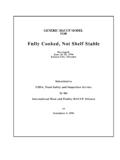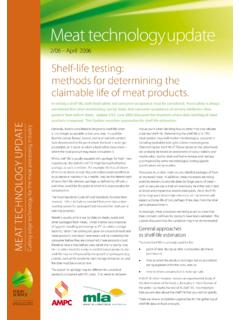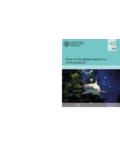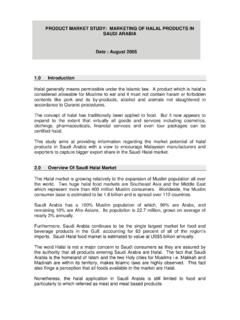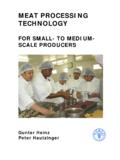Transcription of A GUIDE FOR THE PREPARATION OF THE - Gurrentz
1 VA GUIDE FOR THE PREPARATIONOF THEMEAT SAFETY QUALITYASSURANCESYSTEM(MSQA)FORFRESH MEAT&PROCESSED MEAT PRODUCTSSECOND EDITIONP repared byMeat Inspection DivisionAustralian Quarantine and Inspection ServiceCanberraviCONTENTS1. INTRODUCTIONvPage NumberIntroductionPart 1 THE COMPANY QUALITY SYSTEMII ntroduction and Scope of the MSQA SystemIIMSQA Manual Format and Layouta. General Approachb. Manuals and Work Proceduresc. Formatd. Alignment of the MSQA System with ISO9002:1994 Elements1 Company Quality Policy Statement2 Declaration by the Management3 Schedule of Processes and Products4 Company Organisational Chart5 Functions and Duty Statements for All Company StaffControlling the MSQA System6 Description of the MSQA System7 Document Control Access.
2 Approval and Amendments to the CompanyMSQA Manual Access to AQIS Legislative Requirements and OtherNotices AQIS Accountable Items8 Purchasing9 Control of Customer-Supplied Product10 product Identification and Traceability product Identification product Recall11 Process Control Layout of Establishment12 Inspection & Testing Receival Inspection and Testing In-Process Inspection and Testing Final Inspection and Testing13 Inspection, Measuring and Test Equipment14 Inspection and Test Status15 Control of Non-Conforming Product16 Corrective Action17 Handling, Storage, Packaging, Preservation andDeliveryvii Handling Storage and Preservation Packaging Delivery18 MSQA Records19 Internal Audit and Management Review Internal Audit Management Review Feedback of Results to Improve the MSQA System20 Company Training21 Statistical TechniquesPART 2 - The Application of HACCP and Good Manufacturing Practice22 Introduction23 Definitions24 Pre-Requisite Programs25 Work Instructions26 Monitoring27 Purpose and Principles of HACCP28 Developing the HACCP the MSQA the product and the Method of its the Intended Use and Consumers of the a Flow Diagram Which Describes the the Flow - Hazard - Identify the CCPs in the
3 Process atEach No 3 - Establish Critical No 4 - Establish Monitoring No 5 - Establish Corrective Action To No 6 - Establish Vertification No 7 - Establish Record - KeepingProceduresAppendix A: Examples of Questions to be Considered in a Hazard AnalysisList of FiguresFigure 1 Examples of Quality System DocumentationFigure 2 Company Organisational ChartFigure 3An Example MSQA Amendment RegisterFigure 4 Relationship Between good Manufacturing Practice and HACCPF igure 5 Logic Sequence for Developing a HACCP PlanFigure 6 Example of a Simple Flow Diagram for Part of a Beef Kill FloorFigure 7 Example 1 of a CCP Decision TreeFigure 8 Example 2 of a CCP Decisiion TreeFigure 9 Example of Corrective Action Decision Tree for Company MonitorsFigure 10 Model of Relationship Between Vertification and Management ReviewviiiList of TablesTable 1 Alignment
4 Between MSQA Manual and ISO FormatTable 2 Examples of How the Stages of Hazard Analysis are Used to Identify andEvaluate HazardsTable 3 Examples of Decision Making Process in Determining CCPs at Some Stepsin Pig SlaughterTable 4 Examples of Decision Making Process in Determining CCPs at Some Stepsin Beef SlaughterTable 5 Sources of Information for Safety Criteria and Critical LimitsTable 6 Examples of Measures Used in Critical LimitsTable 7 HACCP TableTable 8 Example of HACCP Table Using Chilling of Pork Carcases as ModelTable 9 Example of HACCP Table Using Chilling of Beef Sides as ModelvINTRODUCTIONMeat Safety Quality Assurance (MSQA) Second EditionThe second edition of the MSQA GUIDE replaces the original GUIDE published in developments in the area of food safety generally, and meat safety inparticular, have resulted in the need to revise the original MSQA system to make is MSQA?
5 MSQA is a system developed by AQIS. It is based on a modification of the ISO9002:1994 standard and utilises the Codex Alimentarius Commission Hazard AnalysisCritical Control Point (HACCP) methodology to address process control. It. aims toprovide export meat establishments with an integrated system which, when appliedrigorously, will assist in the production of safe meat and meat products for is MSQA Needed?Domestically and internationally the safety of meat and meat products has andcontinues to attract attention from consumers and governments alike. Recent seriousfood poisoning incidents attributable to contaminated meat has further raised the needfor systems governing meat production which properly and effectively control thehazards which can compromise meat a regulator, AQIS has a responsibility to ensure that meat production systemsresult in safe to eat products, as free as possible from hazards potentially injurious tohumans.
6 Traditional approaches to process control have proven their inability to fullysatisfy this goal. AQIS has been employing various quality assurance based systemsin the meat industry for the past decade. It is clear that better meat safety outcomescan be achieved through the application of a systems approach to the identification,analysis, prevention and control of 1996 and 1997, the Meat Industry Council sponsored several projectsinvolving the application of HACCP and quality assurance in selected meatestablishments. As a result of AQIS s involvement in these projects, together withrapid developments internationally with the application of HACCP in meatprocessing, it became clear that the original MSQA needed further second edition of the MSQA GUIDE is the result of this process.
7 It will assist inthe design of a quality system which provides a framework for establishments toconsistently achieve: good meat safety outcomes; compliance with AQIS requirements; and potentially improve overall business performance throughstandardised, rigorous management A NEW MSQA OR CONVERTING AN wishing to develop a new MSQA or convert their existing AQA toMSQA should contact and discuss the new system or proposed changes is recommended that a timetable be established for conversion of existingAQAs with deadlines for the various stages, such as: planning and training an incremental approach to conversion or development may also beconsidered where one section of a plant is completed before starting onother all the components of the company s MSQA system (as detailed in thisGuide) have been written and implemented, the company may then apply to theArea Technical Manager for approval of the are encouraged to involve AQIS staff in the development of thesystem as they are soundly placed to offer advice on the best practices to 1 THE COMPANY AND SCOPE OF THE MSQA SYSTEMi)
8 Part 1 of this GUIDE describes a framework in which to develop and designthe operational procedures that will drive the MSQA system. Elements 1 to21 set out the requirements of an MSQA system. Companies may wish to develop an integrated manual which includes otheraspects of a quality management program such as in-house company QA,AUS-MEAT language, as well as the MSQA ) All categories of export plants can operate under an MSQA systemincluding: abattoirs independent boning rooms meat processing establishments; and cold stores and freight handling facilities. The principles in this GUIDE may also be applied to the game meat, poultry andrabbit processing ) The scope of operations that an MSQA can cover are.
9 Receival and handling of livestock - this includes identification,controls on chemical residues, cleanliness of stock and animal welfare slaughter and dressing - from stunning to the chiller offal rooms - from receival of green and red offal to carton strapping chilling, freezing and cold storage - of carcases, carcase parts,packaged meat and offal boning rooms - from carcase break-down to carton strapping PREPARATION and wrapping of carcases for export load-out/in - for inter-establishment transfer and direct export establishment and equipment sanitation - all aspects meat products animal food and inedible material - including security; and export MANUAL FORMAT AND LAYOUTC ompanies are required to document their quality system describing allprocedures employed within the scope of the quality system which will ensurethat: food safety issues are addressed importing country requirements are met.
10 And AQIS requirements are company s quality system may cover operations outside the scope of theMSQA system. These will not be subject to audit by ApproachThe fundamental purpose of quality system documentation is to GUIDE staff. Tomeet this purpose, documentation must be: useable easy to understand; and achieve this: use tables, diagrams and other forms of easily assimilated instructionswherever possible group similar sections together, rather than scatter references cross-reference thoroughly, particularly recording sheets or logs identify recording sheets or logs by a title and form or document number,both of which should be quoted whenever the form is referred to.


